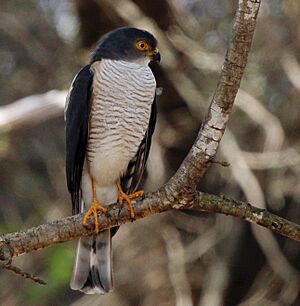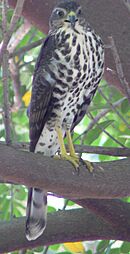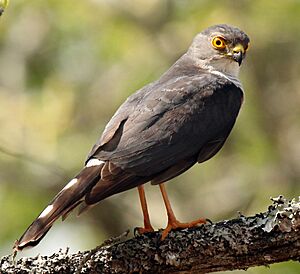Little sparrowhawk facts for kids
Quick facts for kids Little sparrowhawk |
|
|---|---|
 |
|
 |
|
| At Phinda Game Reserve, South Africa, showing ventral and dorsal plumage | |
| Conservation status | |
| Scientific classification | |
| Subspecies | |
|
|
| Synonyms | |
|
The little sparrowhawk (Accipiter minullus) is a small, fast bird of prey from Africa. It's the smallest type of sparrowhawk and is known for its quick hunting skills. These birds belong to the Accipitridae family, which includes many types of eagles, hawks, and kites. It is found in many parts of Sub-Saharan Africa.
Contents
Meet the Little Sparrowhawk: Appearance and Size
The little sparrowhawk is a very small bird of prey, just like its name says! It has two white spots on the underside of its middle tail feathers. It also has a thin white patch on its lower back.
These birds show sexual dimorphism, which means males and females look a bit different.
- Males have dark grey upper parts, which can look almost black. This dark color extends to their cheeks, making a nice contrast with their white throat. Their undersides are white with thin reddish-brown bars.
- Females are generally browner on their upper parts. The bars on their undersides are also browner and not as fine as the male's.
- Young birds (juveniles) are browner all over. Their upper feathers have pale tips. Their undersides are spotted with brown instead of barred. The white on their rump feathers is only at the tips.
In adult birds, the beak is black, and their long legs and toes are yellow. Their cere (the waxy part at the base of the beak) is yellow, and their eyes are a deep yellow. Young birds have a yellowish-green cere and brown eyes.
The little sparrowhawk is about 23–27 cm (9.1–10.6 in) long. Its wingspan is about 39–50 cm (15–20 in). Males weigh around 74–85 g (2.6–3.0 oz), while females are a bit heavier, weighing about 68–105 g (2.4–3.7 oz).
Where Little Sparrowhawks Live: Habitat and Range
The little sparrowhawk lives in eastern and southern parts of Sub-Saharan Africa. You can find them from Ethiopia in the north, all the way south to the Democratic Republic of Congo and northern Angola. They also live as far south as the eastern Western Cape in South Africa.
These birds prefer living in woodlands. They can often be found in patches of trees and bushes, especially along river valleys. In drier areas, they might live in open spaces like fynbos (a type of shrubland) and grasslands. They are also sometimes seen in suburban gardens.
Life of a Little Sparrowhawk: Behavior and Habits
Reproduction and Family Life

Little sparrowhawks are monogamous, meaning they have one mate at a time. They are also territorial, which means they defend their nesting area. They build their nests alone.
When a male wants to attract a female, he might perch parallel to a branch and sway his head from side to side. The female does most of the nest building. She creates a small platform out of sticks, lining it thinly with green leaves. She usually places the nest in the main fork of a tree. They often choose non-native trees like Eucalyptus, poplars, jacaranda, and weeping willow. Sometimes, they even use old nests built by other birds, like the shikra or gabar goshawk, instead of building a new one.
In southern Africa, females lay one to three eggs between September and December, with most eggs laid in October. Both parents incubate the eggs for about 31–32 days, but the female does at least three-quarters of the incubation. The male regularly brings food to the female while she is incubating and brooding the chicks. He also protects the nest from other birds, chasing away any intruders, especially other birds of prey. The young birds leave the nest when they are about 25–27 days old. They stay in their parents' territory for up to a year. In other parts of Africa, breeding has been seen from March to April in north-eastern Africa and from October to November in western Kenya.
What Little Sparrowhawks Eat: Hunting and Diet
The little sparrowhawk is a bird hunter. It waits hidden in cover, then makes a short, fast dash to catch its prey in flight. Their main food is small birds, up to the size of a thrush or a dove. They might also catch bats. Sometimes, they take prey from the ground, including frogs, lizards, and rodents. Larger insects and termites are also part of their diet.
Who Hunts the Hunters: Predators

Adult little sparrowhawks can be hunted by other birds of prey, such as the gabar goshawk (Micronisus gabar). Young sparrowhawk chicks have sometimes been caught by lizard buzzards (Kaupifalco monogrammicus).



